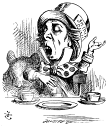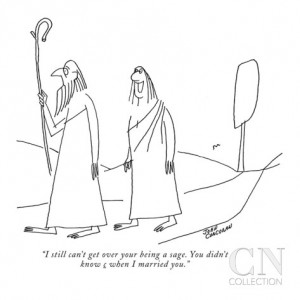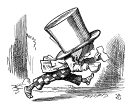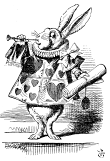Search us!
Search The Word Detective and our family of websites:
This is the easiest way to find a column on a particular word or phrase.
To search for a specific phrase, put it between quotation marks. (note: JavaScript must be turned on in your browser to view results.)
Ask a Question! Puzzled by Posh?
Confounded by Cattycorner?
Baffled by Balderdash?
Flummoxed by Flabbergast?
Perplexed by Pandemonium?
Nonplussed by... Nonplussed?
Annoyed by Alliteration?

Don't be shy!
Send in your question!
Columns from 1995 to 2006 are slowly being added to the above archives. For the moment, they can best be found by using the Search box at the top of this column.
 If you would like to be notified when each monthly update is posted here, sign up for our free email notification list.
If you would like to be notified when each monthly update is posted here, sign up for our free email notification list.
Trivia
All contents herein (except the illustrations, which are in the public domain) are Copyright © 1995-2020 Evan Morris & Kathy Wollard. Reproduction without written permission is prohibited, with the exception that teachers in public schools may duplicate and distribute the material here for classroom use.
Any typos found are yours to keep.
And remember, kids,
Semper Ubi Sub Ubi
|
Paint it mauve.
Dear Word Detective: I’d appreciate your detailing the origin of “chartreuse,” the color. I understand it’s from the color of a French liqueur. — Warren I. Pollock.
Ok, chartreuse. Which one is that again? Y’know what’s funny is that while I’m not colorblind and can easily tell red from green and so forth, I seem to be color-name blind. Major colors, no problem. But mention “chartreuse,” “mauve” or some other weirdo hue and I draw a complete blank. I mean, what the heck color is “fuchsia”? Sounds like something you’d catch from toads. Teal? Ecru? What? Don’t bother telling me, because I’ll forget it in five minutes. My brain is apparently wired for primary colors only.
It is true that the color “chartreuse” is named for the color of “chartreuse,” a liqueur made by the monks of La Grande-Chartreuse, which is the chief monastery of the Roman Catholic Carthusian order in the Chartreuse range of the French Alps. The liqueur Chartreuse, made from herbs and brandy, is a pale apple-green (as distinct to the rich emerald green of absinthe, which is, of course, made of wormwood and pure evil). The monks, or their subcontractors, have been cranking out this Chartreuse stuff since the early 17th century, although the order was actually founded in 1084. (That’s 600 years they’re gonna have to explain on their time sheets.) The color “chartreuse” is halfway between green and yellow, and color aficionados recognize two variant hues, “chartreuse yellow,” skewed toward yellow, and “chartreuse green,” skewed toward guess what. Fire trucks and other emergency vehicles are often painted “chartreuse yellow” these days because it’s considered a more visible and distinctive color than the traditional red. That’s probably why a disaffected homeowner in a bland development near us repainted his entire house (formerly a noxious putty color) blinding chartreuse yellow in protest a few years ago. It was awesome, but the homeowners’ association was not amused and prolonged lawsuits ensued.
Elsewhere on the Spectrum of Mystery, it turns out that “mauve” is, to quote the Oxford English Dictionary (OED), “Any of a range of light shades of purple between lilac and violet.” It’s a good thing they threw that “purple” in there, because I know that lilac and violets are two kinds of flowering plants, but I can’t quite picture them. Anyway, “mauve” (which appeared in the mid-19th century and is pronounced either “mawve” or “mowve” in the US) comes from the French “mauve” meaning “mallow plant,” mallow being a family of flowering plants related to cotton and okra.
“Ecru” is my kind of color. It’s the color of unbleached linen, i.e., a pale beige or off-white. The word “ecru” is, in fact, French for “unbleached” or “raw” (derived from the Latin “crudus,” raw). “Ecru” first appeared in print in English in 1869.
“Teal” comes from the Old English “tele,” which has close relatives in German and Dutch. A “teal” is a kind of small duck, in fact, according to the OED, “the smallest of the ducks” (to which I am tempted to reply “What ducks? I don’t see no ducks.”). Teals are supposedly common in Europe, Asia and America. The color “teal” (first appearing in 1923) is “a shade of dark greenish blue resembling the patches of this color on the head and wings of the teal.” (OED). I am told that to this day interior designers often carry an actual live teal in a small box in order to compare it to paint and fabric samples, but I think someone may be goofing on me. Lastly, “fuchsia” (also debuting in 1923) is a shade of red named after the flowers of the “fuchsia” (pronounced “FOO-shiyah”) shrub, which was named after the 16th century German botanist Leonhard Fuchs.
Too bad. “Thrity” has a nice ring to it.
Dear Word Detective: I have been wondering about this since grade school: Why do we say “first” and “second,” which seem totally unrelated to the words “one” and “two”? “Third” at least somewhat resembles “three.” And the rest – fourth, fifth, sixth, etc. – pretty much just add “th” to the number. So why don’t we say “oneth,” “twoth,” and maybe “threeth”? — Rosemarie Eskes, Rochester, NY
That’s a good question, and there seem to be a lot of people out there on the internet asking the same thing. Unfortunately, the answers they’re getting at places like Yahoo Answers are, shall we say, not quite right. My favorite one confidently (but loonily) explains that “In most competitions, there is the importance of the first three rankers. It is possible that the words, first, second and third were coined for the first three winners. One having rank four was never recognized for prize distribution. So no special word was coined for rank 4 and so on.” I guess you could call this the State Fair Pie Contest theory. Remember, kids, losers don’t get a special word!
“First,” “second,” “third,” “fourth” and so on are called “ordinal numbers,” terms defining a thing’s place in a series (as opposed to “cardinal numbers,” such as “one,” “two,” “three,” etc.). The word “ordinal” comes from the Latin “ordo,” meaning “row or series,” which also gave us “order.” Ordinals can be used as nouns, pronouns or adjectives, and can be written either as words (“third”) or as numerals with suffixes approximating the sound of the word (1st, 2nd, 3rd, 4th, etc.).
The form of almost all English ordinals is regular, predictable and no mystery at all. Old English used the ending “tha” to form ordinals, which we retained in the form “th” (or “eth”) and use to cover everything from “fourth” to “five hundred billionth” and beyond. Just why the ordinals corresponding to “one,” “two” and “three” in English diverged from this pattern is unknown — stuff happens — but almost certainly had nothing to do with contests.
Our modern English word “first” was “fyrst” in Old English, and came from the Germanic root “furisto,” which was a superlative form of the root “fur,” meaning “before, preceding” (which also gave us “fore” and the prefix “for,” connoting “before” or “in front of”). So the sense of “first” was “absolutely before anything else.” As you might expect, “first” has acquired a range of extended meanings in various terms, such as “first aid” (medical aid delivered at the scene of injury) and “firsthand” (in “first person” experience, as opposed to “secondhand,” via another person).
To designate the thing that came immediately after the first thing, English originally simply used the word “other.” For obvious reasons, this use of “other” created confusion with all the, um, other uses of “other.” So around 1300, English borrowed “second” directly from French, which had derived it from the Latin “secundus,” meaning “following” or “next in a series” (also the source of our modern “sequel”).
“Third” came to us from the Germanic “thridda,” closely related to our “three,” which is why “third” and “three” seem similar. They’d be even more alike if a fairly common historical linguistic process called “metathesis” hadn’t reversed the “i” and “r” in “thrid” in the 16th century to make “third” (and led to the cardinals “thirteen,” “thirty,” etc., rather than “thridteen” or “thrity”).
Things are pretty straightforward from then on, with the exception of “eleventh” (“eleven” coming from the Old English “endleofan,” meaning “one left over, i.e., one more than, ten”) and “twelfth” (“twelve” being from the Old English “twelf,” literally “two left” over ten).
To boldly hit “print.”
Dear Word Detective: Recently, I got to wondering about the word “font.” There are several definitions, including a baptismal “font,” a typeface and someone, like yourself, a “font” of wisdom. I can accept that there might be some similarity between a baptismal font (water being splashed about generously) and a “font of wisdom” (wisdom being splashed about generously), but how do typefaces fit into the picture? Even more obscure, perhaps, is the word “fontanelle.” My sources suggest it comes from a similar source as the other meanings of font — i.e., a little spring. Ew. — Jim Brown.
“Font of wisdom”? OK, that got the cats snickering. When I was a kid, my mother framed a cartoon from the New Yorker and put it on the wall of the home office she shared with my father (who started this column in 1954). It showed a woman laughingly addressing her husband, a stereotypical bearded wise man in robes, saying “I still can’t get over your being a sage. You didn’t know beans when I married you.” (Interestingly, if you Google “beans sage cartoon,” you’ll find that the New Yorker is selling prints of that cartoon.)
Explaining how a baptismal “font” could possibly be related to the sort of “font” you use on your computer turns out, thankfully, to be unnecessary. There are actually two separate and completely unrelated “fonts” in English.
The typeface kind of “font” is the easier to explain. We use “font” loosely to mean a style of type (e.g., Comic Sans, the official Microsoft font), but, more precisely, a “font” is a complete set of a certain style of type, i.e., including a complete alphabet, punctuation, numerals, etc. This “font” first appeared in English in the late 16th century, based on the French “fonte,” from “fondre,” meaning “to cast” as one “casts” objects from molten metal. The first use of “font” in English was, in fact, to mean simply “cast iron.” Type at that time was, of course, cast from metal, but it wasn’t until the late 17th century that “font” (then often in the form “fount” or even “found”) was used in the “family of type” sense (“Break down the Printing-Presses, melt the Founds.” 1723).
“Font” in the other senses you mention is from a different source, the Latin “fons,” meaning “spring” or “fountain.” (“Fons” is also the ultimate source of “fountain.”) The earliest use of “font” in Old English was to mean a receptacle for water in a church used for baptism, etc. The form “fount,” which had the same source but is sometimes considered a different word, popped up in literary use in the 16th century with the meaning “spring, source” in both literal and figurative senses (“Ancient founts of inspiration well thro’ all my fancy yet.” Tennyson, 1842). This is the elusive “fount” or “font” of wisdom. As to which is correct in this sense, both are; although the poetic use of “fount” has made “fount of wisdom” more popular, “font” seems to be gaining on it in recent years.
“Fontanelle” comes directly from French, where it means literally “little fountain.” The most common uses of “fontanelle” are for the depression or hollow between two muscles or the areas of a baby’s skull that remain soft and flexible for the first year or so after birth. (The human skull is actually made up of six separate bones that fuse together over time.) The use of “fontanelle” for these spots (and the space between muscles) comes from the slight depression at such places, similar to a spring in a shallow hollow of the earth.
|
Makes a great gift! Click cover for more.  
400+ pages of science questions answered and explained for kids -- and adults!
FROM ALTOIDS TO ZIMA, by Evan Morris
 
|


 can be found
can be found 





Recent Comments